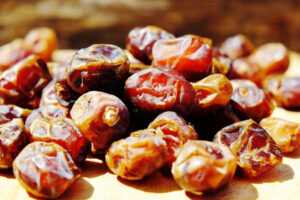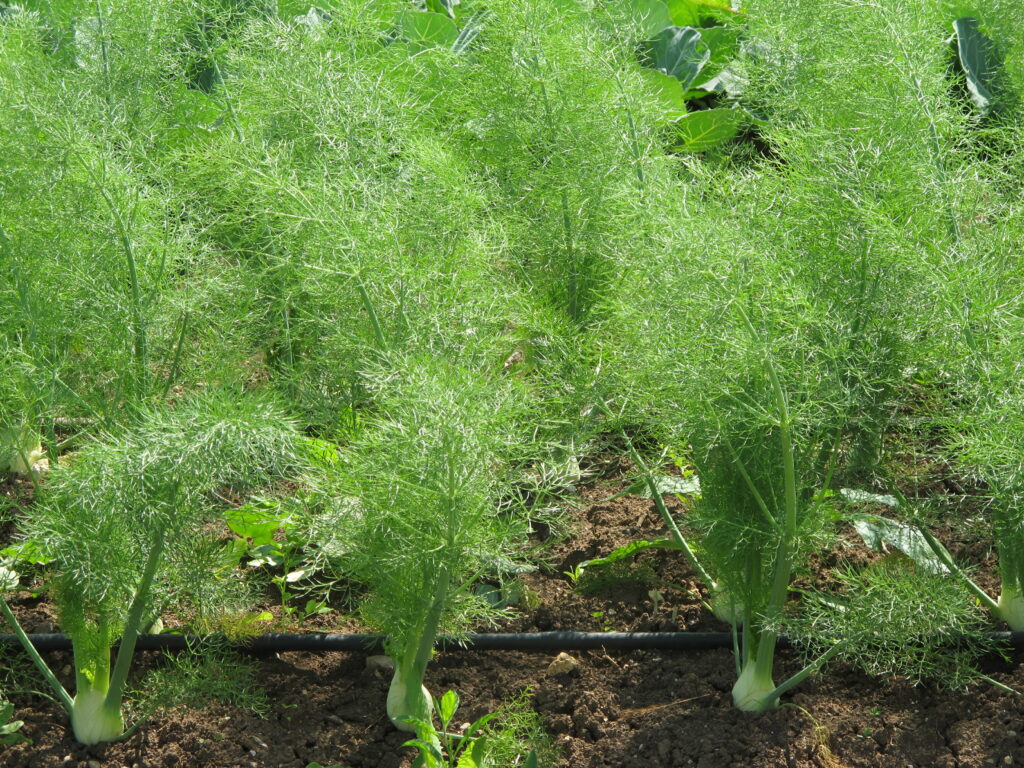Bringing you up to Date:
 We are delighted to renew our fresh supply of delectable Samar dates from this very autumn’s harvest. To those of you who are already addicted, yearning for and impatiently awaiting these heavenly morsels – they’re here! To those of you unfortunate enough to have not yet taken a taste, rejoice! It’s time to discover the spectacular organic dates grown by Kibbutz Samar in the deep south of Israel.
We are delighted to renew our fresh supply of delectable Samar dates from this very autumn’s harvest. To those of you who are already addicted, yearning for and impatiently awaiting these heavenly morsels – they’re here! To those of you unfortunate enough to have not yet taken a taste, rejoice! It’s time to discover the spectacular organic dates grown by Kibbutz Samar in the deep south of Israel.
The three Samar date varieties you can add to your Chubeza boxes include:
Barhi dates – Round, soft and super sweet, better known in their fresh yellow form. Samar experimented by drying them on the trees, as they do with the other types of dates, and the results were a rare delicacy of distinctively delicious taste and texture. Samar terms the Barhi treats “nature’s toffee,” and they are dangerously addictive (while fortifying you with fiber, iron, potassium, B-vitamins, flavonoids and antioxidants).
Noor dates – Elongated, dark and drier. Plus, they’re less sweet. One bite and those of you who are loved Yemenite or Iraqi dates will be awash with a sweet wave of nostalgia.
Zahidi dates – Small and round, less sweet than the Barhi, and rich in dietary fibers. The non-sweetcaholics among you will enjoy the two latter varieties. They are also perfect for baking and cooking.
Samar dates are available in two sizes: 5 kg or 500 gr. Add them to your boxes today via our order system!
_____________________________________
Next week we celebrate Chanuka, and then it’s time to bid farewell to 2019. We are in hopes that the winter continues to make us happy with rainy days and some sunny ones, winds, fog and low temperatures. Just as it should be.
In European mythology, winter represents the month where nature wilts and dies, and growth halts or goes into slumber. This is true, of course, regarding the harsh, freezing winters of northern Europe, but not at all relevant to the moderate rainy (and cold, but usually not freezing) climate of the Middle East, Israel included, especially when compared to the scorching hot summers. Here, at the beginning of winter, olives are harvested to produce olive oil, as are dates and citruses which are garnered in large quantities. Goat owners enjoy the delectable milk following winter kidding and beekeepers also have it easier after the dry summer blossoming resumes and bees go back to producing honey as opposed to just surviving.
Thus, we have replenished our stock of Samar dates; honey from Ein Harod and the Golan Heights; olive oil, hummus, almonds and teff from Ein Harod; dairy products from Izza Pziza (soon to be restocked with bountiful quantities of milk and a large variety of cheeses). Along with these delicacies, we are blessed with Udi’s excellent sprouts and mushrooms; granola and pastries from Ish Shel Lechem Bakery; date jam and snacks from Neot Smadar; flour varieties from Minhat Ha’aretz; apple vinegar, cider, juices and jams from Tomer’s Matsesa; the unique Shorshei Zion products; Lechem Pele‘s legume and grain gluten-free breads; Danny and Galit’s cookies; Tahi-na from Netiv Halamed Heh; tahini and coffee from Helaf’s M’lo HaTene; crackers from Lev Hateva; fruit leather and dry fruits from Melissa’s Mipri Yadeha and Orli’s honey candies. All this incredible profusion comes together to create a joyful wintery bounty.
The field is celebrating with winter renewal. True, we are duly preparing for frost and hail to protect the greens from those blights, but the challenges of dealing with pests decrease, partly because they go into hibernation and also because our plants are strong and healthy. One look at the vegetable plots, bursting in beautiful green growth, makes it clear that here at Chubeza, Persephone is not to be found in the underworld but rather cooking a steamy pot of yummy vegetable soup for dinner.
One of those veggies who thrives in wintertime is the fennel, the star of this week’s Newsletter.
The beautiful photos of our field are, as usual, courtesy of the one and only Chana Netzer. (Thank you, Chana!)

Fennel belongs to the Umbelliferae family, a relative of the dill, coriander, carrot, parsley, celery, anise, cumin and others. The fennel’s origins are in the Mediterranean basin– a neighbor! As it is well-accustomed to our surroundings, fennel grows peacefully and comfortably in many wild fields, and easily overtakes abandoned agricultural plots or even the random open urban field. It understands our fickle weather, demands order from the weeds surrounding it, lest they encroach on its territory, and grows in search of the winter sun, sometimes reaching a height of two meters! Fennel is indeed a strong plant: it successfully endures weather fluctuations, even extreme ones (perfect for the Israeli winter), and hardly ever suffers from pests, perhaps thanks to its strong scent. When it is big enough, fennel gets along well with the weeds, staking out a territory for itself. Fennel’s dominant character is the reason it is recommended to avoid placing other plants alongside, and to give the fennel its own turf and garden-bed, though I must say in my own experience I have never seen it take over neighboring beds or influence them otherwise.
Contrary to other cultivated vegetables, the Florence fennel we grow is not very different from its brother, the wild fennel, except for the fact that it is shorter and puts most of its energy into thickening the leaves at its base until they become a sort of white bulb, sweet and juicy, which we can eat. Here too, it is a mistake to think we eat the root or bulb of the fennel when in fact we’re eating its lower leaves that grow out of the base of the stem, which in the case of the Florence fennel are puffy and fleshy. These leaves taste more delicate and sweeter than the wild and common fennels, grown to extract seeds.
The vegetable’s aroma and distinctive taste derive from a unique phytochemical, anethol, which is the main component of the volatile lubricant it contains (similar to anise). This phytochemical retards inflammation and reduces the threat of cancer. The volatile lubricant in fennel can also protect from various chemical toxins in the liver and other organs. Its strong smell can be used to refresh and prevent bad breath (if you fancy its aroma), and it is a component in most natural toothpastes. Those who do not enjoy the smell can identify with the pests who keep their distance from fennel, and with medieval witches, who were scared off by sheaves of fennel and St. John’s Wort hung on thresholds during the June 24th European agricultural summer festivities.
But let’s continue to sing its praises…… The ancient Roman writer Plinius Secundus, otherwise known as Plini the Elder, wrote highly of the fennel. He attributed 22 medicinal qualities to fennel, including the fact that snakes eat it while shedding their skin and sharpen their sight by rubbing up against it. Fennel is considered an important medicinal plant, one of nine Anglo-Saxon sacred herbs (along with mugwort, plantain, watercress, betony, chamomile, nettle, crabapple and chervil). The oil is found primarily in the seeds, which are a major component in Chinese and Bengali (Indian) Chinese spice blends.
And a little more flattery: the fennel’s (its seeds, but not exclusively) main claim to fame is as a digestive aid. In India it is served at the end of a meal (in Indian restaurants it comes with the bill, instead of sticky toffee) and chewed in order to help the food go down well. Perhaps this is the reason fennel is considered to be a good diet supplement. The leafy bulb is rich in dietary fibers which in themselves contribute to efficient, healthy digestion. Fennel is also recommended for colicky babies. Even I drank the… hmmm, how shall I describe it… strong-tasting brew, composed of fennel seeds and anise stars, to help my firstborn Neta during colic spells. Young mothers who are known for their willingness to do whatever it takes will be rewarded twofold by imbibing the fennel: helping the baby and increasing their own milk. And if that still doesn’t work and the baby keeps screaming, a fennel drink will help his/her throat, relieving hoarseness and coughs…
But the fennel has a dark side as well, depending on how you look at it. It is one of the spices in absinthe, a strong alcoholic liquor made of wormwood, moss, anise, Melissa and fennel. Absinthe’s anise-taste and green color give it the nickname “the green fairy.” Absinthe has been known to cause hallucinations (or to inspire the muse, depending on who you ask) and was very popular in the 19th century with bohemians and artists, with Van Gogh being one big aficionado. Some claim that he cut off his ear under the influence of absinthe.
Oh, let’s forget about hallucinations for a minute, and take a deep breath. If you’ve decided to go out picking wild fennel flowers, you can add them to Vinaigrette, salads, soups and sauces. If you chop the flower very thinly (or use a mortar and pestle) and mix with soft butter, you can make a great spread for fish or grilled chicken. The flowers can also be used for décor. The seeds should be gathered immediately after the flowers have bloomed and withered and the seeds are still green and fresh.
This week we don’t ask for much, only a nice wintery week for us all, and lots and lots of blessed rain.
Alon, Bat Ami, Dror, Orin, Yochai and the Chubeza team
______________________________________
WHAT’S IN THIS WEEK’S BOXES?
Monday: Swiss chard/New Zealand spinach, kohlrabi/turnips, sweet potatoes, scallions/onions, cucumbers, tomatoes, beets/fennel, carrots, lettuce/arugula/mizuna, cabbage/eggplant/green bell peppers. Small boxes only: Celery/celeriac.
Large box, in addition: Daikon/baby radishes, totsoi/kale, Jerusalem artichokes/Lubia Thai yard-long beans/broccoli/peas, parsley/dill.
FRUIT BOXES: Red apples, bananas, avocadoes, red oranges.
Wednesday: Swiss chard/New Zealand spinach/kale, kohlrabi/turnips/fennel, sweet potatoes, fresh onions, cucumbers, tomatoes, beets, carrots, lettuce, arugula/parsley/dill. Small boxes only: Celery/celeriac. And a special gift for all: mizuna.
Large box, in addition: Daikon/baby radishes, cabbage/eggplant, totsoi/scallions, Jerusalem artichokes/Lubia Thai yard-long beans/peas.
FRUIT BOXES: Red apples, bananas/clemantinot, avocadoes, red oranges.

